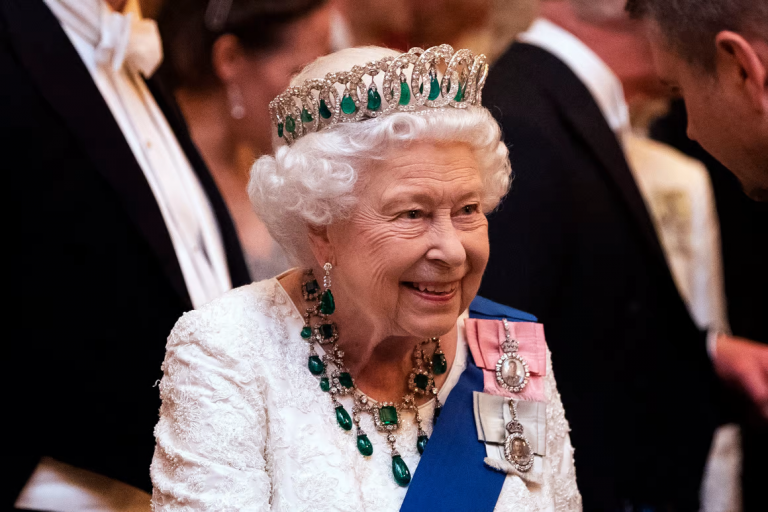The 96-year-old monarch acceded to the throne in 1952 at the age of 26. Revered by the British public, she was an unemotional sovereign who left a lasting imprint on the monarchy.

The year is 1991. In Harare, the capital of Zimbabawe, at the end of a Commonwealth summit, Elizabeth II appears in the marquee on the lawn of the British High Commission. The guest freezes. The sovereign is smaller than you might imagine. Her handshake is limp and her voice nasal, the ends of her sentences trailing off. And yet she exudes a natural authority. She looks her guest up and down with the faintest hint of a smile. Conversation is limited to two banal questions. A short silence ensues. The queen disappears. The monarch excels at this role: appearing at once accessible and inaccessible. She is a true queen, as former French president François Mitterrand once declared admiratively.
One always had the impression of having already seen Elizabeth II in a wax museum like at Madam Tussauds in London. The queen, who died on Thursday, September 8, at the age of 96, was a living page of history who worked with no fewer than 15 British prime ministers, 13 American presidents and all the heads of state of France’s Fifth Republic. She held audiences with political personalities from all over the world, from Churchill to de Gaulle, to Kennedy and Nehru.
She was also a symbol. Under her reign, the United Kingdom saw the joys of success and the pangs of defeat, demonstrating that the monarchy could be the connecting thread between the old, broken order and a new one yet to be invented.
Courteous And Unflappable
The most photographed and painted monarch in the world, Elizabeth II was perhaps more of a living computer. Had she not been Queen, walled up in the silence and dignity that befits not only a head of state and head of an Empire – now a Commonwealth – but also the head of the army and the Supreme Governor of the Church of England, what a writer of memoirs she could have been! It makes you wonder, though, if this small, shy, poorly-educated woman secretly hated her role all her life. No one was ever able to read on her impassive face the secrets that she took to the grave.

HM Queen Elizabeth II pictured in 1964 at Sandringham, stroking her favorite horse ‘Betsy.’ Godfrey Argent / CAMERAPRESS / GAMMA-RAPHO
Little touched by literary or artistic concerns, Elizabeth II was instead the very essence of the English landed gentry, devoted to the cult of animals. When not carrying out her official visits, she was always surrounded by her beloved corgis, who were treated with the utmost care.
There was always the same composure in the most dramatic situations, the same sense of control when faced with trying events. The photo showing her sitting alone at a pew in the chapel of Windsor Castle, dressed in black in front of the coffin of her husband Prince Philip at his funeral on April 17, 2021, sums up her stoicism. Courteous and unflappable, she never blinked at the tabloid press’ cruel attacks on her family, especially during the crisis caused by Princess Diana’s death in a car crash in Paris on August 31, 1997.
The Queen remained inscrutable, even during the dramatic rupture that her grandson Harry and his wife Meghan Markle made with the rest of the royal family in 2020, as well as by their accusations of racism against the Windsors – accusations, however, that didn’t include the sovereign. Instead, she only released a statement in an attempt to ease tensions. Similarly, she expressed nothing when her son Andrew was accused of sexually assaulting a minor, but removed his military titles and charity patronages in January 2022. Even to her few friends, Elizabeth II did not give herself away.
When she was born in London in the elegant district of Mayfair on April 21, 1926, nothing indicated that Elizabeth Mary Windsor would one day accede to the throne. She was the first child of the Duke and Duchess of York. The Duke was the second son of King George V, who was succeeded on January 20, 1936, by Edward, Prince of Wales. As the niece of the future king, she was set to become simply a minor member of the royal family.
Horses : Her life’s Passion
Her childhood was idyllic. But on December 10, 1936, following her uncle Edward VIII’s abdication, her father acceded to the throne as King George VI. Elizabeth became Crown Princess at the age of 10 and found herself, along with her parents and younger sister Margaret, thrust into the spotlight overnight.
She quickly started to receive training in her duties as princess. While Margaret was known for her whimsical nature, Elizabeth was characterized by her seriousness and diligence. Her governess Viscountess Marie-Antoinette de Bellaigue taught her French. The princess made her first official speech in French when she was 13 years old at President Lebrun’s state visit to London in 1939.
Elizabeth didn’t go to school. Private tutors taught her German, a language in which she was soon able to hold a conversation, as well as history and a rudimentary introduction to state affairs. The princess learned to ride horses, a sport that would remain her great passion. She loved horseracing and had her own stable in her colors. Family life was calm and balanced, if a little stilted under a rigorous set of rules.
Her beloved father George VI was a shy man, fundamentally kind, but afflicted by a terrible stammer. He was tormented by his new role, which he had neither sought out nor wanted. When the Second World War broke out in September 1939, the King wanted to send his wife and two daughters to Canada, following a suggestion by then-prime minister Winston Churchill. But the queen refused to leave, so the princesses stayed at Windsor Castle, outside London, rather than at Buckingham Palace, which was considered too vulnerable. To raise national morale, “Lilibet,” as Elizabeth was nicknamed, made even more public appearances, wearing her Grenadier Guard’s uniform or the ambulance driver uniform she wore while learning to drive at the Aldershot military camp. At the end of 1944, Elizabeth got her driver’s license, qualifying under the number 230873, and joined the army reserve as an ambulance driver. She would often speak on the radio to her future subjects.
Queen At The Age Of 26
With peace restored, Elizabeth accompanied her parents on their travels in the UK and the Commonwealth and made her first speeches. On November 20, 1947, she married a distant cousin, Philip Mountbatten, who was a member of the Greek royal family. The wedding was one of the first televised events to be broadcast throughout Western Europe. This loving marriage brought Elizabeth both happiness and stability and would produce four children: Charles (1948), Anne (1950), Andrew (1960) and Edward (1964). They would go on to give Elizabeth and Philip eight grandchildren. But meanwhile, the health of Elizabeth’s father, who was suffering from cancer and exhausted by the heaviness of the Crown, began to falter.

British monarch HM Queen Elizabeth II at Buckingham Palace in 1951. Baron / CAMERAPRESS / G19




